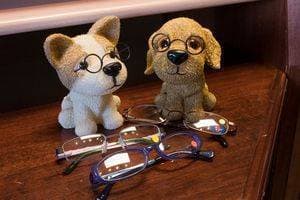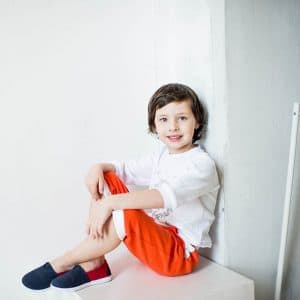A variety of treatment options have been shown to strengthen the eye-brain connections necessary for binocular vision.
Lazy eye can be treated through different means— depending on the type, severity, and age of the patient.
Traditionally, it has been thought that lazy eye treatment should begin before a child reaches around eight years old, however recent research shows that even after this age, lazy eye can be successfully treated. That being said, the earlier the condition is diagnosed, the better the treatment outcome will be.
Corrective eyewear
The first criteria to treat amblyopia is to ensure that each eye has the highest visual acuity possible. Amblyopia that develops as a result of an underlying refractive error typically responds well to corrective eyewear, which allows the lazy eye to gain the best vision possible, and “get used to” seeing the world more clearly.
According to the Pediatric Eye Disease Investigator Group (PEDIG) research, 77 percent of children with refractive amblyopia showed improved visual acuity within fifteen weeks of wearing corrective eyeglasses.
This research indicates that passive treatment using only eyeglasses, can improve visual acuity. However, the eyeglasses alone do not treat the underlying problem. Therefore, a treatment program of vision therapy is usually prescribed to retrain the eye-brain connections of the lazy eye.
Vision therapy
The most common treatment for amblyopia is vision therapy, which may be recommended in combination with other treatments.
Vision therapy is highly successful for the improvement of visual acuity, binocular vision, visual processing abilities, reading fluency and depth perception.
Modern-day techniques used in vision therapy have shown that optimal long-term results can occur when the two eyes are trained to work together (stereopsis).
Stereopsis develops a deeper neurological connection between the two eyes and the brain.
Vision therapy programs to treat amblyopia may include:
- Accommodation (focusing)
- Fixation (visual gaze)
- Saccades (eye jumps)
- Pursuits (eye tracking)
- Spatial skills (eye-hand coordination)
- Binocular vision (the eyes working together)
- Stereopsis (3-D vision)
A vision therapy program may include the use of lenses, prisms, filters, occluders, and other specialized equipment designed to actively make the lazy eye work. Each vision therapy program is customized to the specific needs of the patient.
Games and activities incorporated into vision therapy may include coloring in special workbooks, dot-to-dot drawing, word games, building blocks, and more. In recent years, advanced digital therapies such as virtual reality games have turned vision therapy activities into interactive and exciting exercises!
Many times, home practice will be recommended to reinforce the office-based treatments. The length of the program depends on the severity of the diagnosis and patient compliance, but most therapy programs range from several weeks to several months.
Contact an eye doctor near you who has experience treating lazy eye with vision therapy to help improve your vision.
SEE RELATED: Until What Age Can a Lazy Eye Be Treated?
Eye patching
Eye patching, usually recommended within a personalized vision therapy program, involves placing an eye patch over the stronger eye— forcing the lazy eye to work and develop a better connection to the brain. Through patching of the “good” eye, the brain will begin to acknowledge and interpret visual signals coming from the lazy eye, thereby recovering vision.
The length of this treatment method depends on the extent of the vision, the age of the child, and how long the lazy eye has been present.
Please note, total eye occlusion of the stronger eye is necessary, without any light filtering through the patch. Decorated eye patches are available for children, to encourage them to wear the patch. Additionally, there are patches that attach to an eyeglass lens, if your child wears eyeglasses.
How many hours/day does your child need to wear an eye patch?
In the past, doctors would recommend full-time patching for lazy eye treatment, for up to 6 or 8 hours every day. However, this recommendation often led to poor patient compliance because of social stigmas and daily hardships.
- Eye patching for moderate lazy eye, for two hours per day with one hour of near vision exercises, is just as effective as patching for six hours per day or even full time patching.
- 62% of patients that patched for two hours per day showed improved visual acuity within about four months of treatment.
Similarly, in cases of severe amblyopia, six hours of patching per day has been shown to be as effective as full-time patching.
Atropine eye drops
Similar to eye patching, atropine eye drops are typically used in combination with a vision therapy program. The drops are applied in the non-affected eye in order to blur vision, and force the lazy eye to become stronger— thereby strengthening the eye-brain connection.
Many parents find the eye drops to be less conspicuous than eye patching, but the drops can cause physical discomfort such as stinging and blurry vision— which may result in inadequate patient compliance.
The good news is that recent research conducted by the PEDIG team has shown that daily use of atropine drops are not necessary for noticeable improvement of vision in moderate to severe amblyopia.
The study reveals that only using the drops on weekends shows equal amounts of improvement.
This finding will likely result in increased compliance and satisfaction with the treatment.
Surgery
In general, if the eyes are aligned then eye surgery is not recommended.
However, if the amblyopia is a result of an eye turn (strabismus), surgery (sometimes even multiple surgeries) may be required to realign the eye muscles and correct the eye turn, in order to improve eye alignment.
About 1.2 million ocular surgeries of these types are performed in the U.S. every year — making it the third most common type of ocular surgery in the country. This surgery can be performed on both children and adults, and is a one-day outpatient procedure with a relatively short recovery period of just a few days.
There are two types of strabismus surgery:
- A recession is performed when the ocular muscle is detached from its original place, and reattached away from the front of the eye, in order to weaken the muscle.
- A resection is performed when a portion of the muscle is removed to strengthen the remaining portion of the muscle.
Surgery for lazy eye treatment may improve vision, but it is not guaranteed to do so. Sometimes, the surgery can improve eye alignment, but the eye-brain connection still requires strengthening —resulting in continued vision problems.
That being said, surgery in combination with eye patching or vision therapy has been shown to increase the patient’s chances of achieving binocular vision.
Which treatment option is right for you?
Your eye doctor will provide all of the information you need to know about lazy eye, and the treatment option best suited for your needs.
In most cases, vision therapy will be recommended for children with a lazy eye— if an eye turn is always present, surgery may be recommended as well.
Many times, adults who suffer from lazy eye will also benefit from vision therapy, even though the program might take longer.
LEARN MORE: Vision Therapy for Lazy Eye
Schedule an appointment with a vision therapy eye doctor near you to start treatment which will improve your binocular vision.










